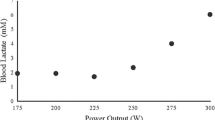Summary
The purpose of the present study was to examine the influence of a respiratory acidosis on the blood lactate (La) threshold and specific blood La concentrations measured during a progressive incremental exercise test. Seven males performed three step-incremental exercise tests (20 W · min−1) breathing the following gas mixtures; 21% O2 balance-nitrogen, and 21% O2, 4% CO2 balance-nitrogen or balance-helium. The log-log transformation of La oxygen consumption (VO2) relationship and a 1 mmol ·1−1 increase above resting values were used to determine a La threshold. Also, theVO2 corresponding to a La value of 2 (La2) and 4 (La4) mmol · 1−1 was determined. Breathing the hypercapnic gas mixtures significantly increased the resting partial pressure of carbon dioxide (PCO2) from 5.6 kPa (42 mm Hg) to 6.1 kPa (46 mm Hg) and decreased pH from 7.395 to 7.366. During the incremental exercise test,PCO2 increased significantly to 7.2 kPa (54 mm Hg) and 6.8 kPa (51 mm Hg) for the hypercapnic gas mixtures with nitrogen and helium, respectively, and pH decreased to 7.194 and 7.208. In contrast, bloodPCO2 decreased to 4.9 kPa (37 mm Hg) at the end of the normocapnic exercise test and pH decreased to 7.291. A blood La threshold determined from a log-log transformation [1.20 (0.28) 1·min−1] or as an increase of 1 mmol·1−1[1.84 (0.46) 1·min−1] was unaffected by the acid-base alterations. Similarly, theVO2 corresponding to La2 and La4 was not affected by breathing the hypercapnic gas mixtures [2.12 (0.46) 1·min−1 and 2.81 (0.52) 1·min−1, respectively]. Blood La values were reduced significantly at maximal exercise while breathing the hypercapnic gas mixtures (5.72±1.34 mmol ·1−1) compared with the normocapnic test (6.96±1.14 mmol·1−1). It is concluded that respiratory-induced acid-base manipulations due to the inspiration of 4% CO2 have a negligible influence on the blood La response during a progressive exercise test at low and moderate power outputs. Lower blood La values are observed at maximal exercise with an induced respiratory acidosis but this negative influence is less than what has been reported for an induced metabolic acidosis.
Similar content being viewed by others
References
Beaver WL, Wasserman K, Whipp BJ (1985) Improved detection of lactate threshold during exercise using a log-log transformation. J Appl Physiol 59:1936–1940
Brien DM, McKenzie DC (1989) The effect of induced alkalosis and acidosis on plasma lactate and work output in elite oarsmen. Eur J Appl Physiol 58:797–802
Brooks GA (1985) Anaerobic threshold: review of the concept and directions for future research. Med Sci Sports Exerc 17:22–31
Bye PTP, Esau SA, Walley KR, Macklem PT, Pardy RL (1984) Ventilatory muscles during exercise in air and oxygen in normal men. J Appl Physiol 56:464–471
Clark JM, Sinclair RD, Lenox JB (1980) Chemical and nonchemical components of ventilation during hypercapnic exercise in man. J Appl Physiol 48:1065–1076
Coyle EF, Martin WH, Ehsani AA, Hagberg JM, Bloomfield SA, Sinacore DR, Holloszy JO (1984) Blood lactate threshold in some well-trained ischemic heart disease patients. J Appl Physiol 54:18–23
Davies SF, Iber C, Keene SA, McArthur CD, Path MJ (1986) Effect of respiratory alkalosis during exercise on blood lactate. J Appl Physiol 61:948–952
Dempsey JA, Fregosi RF (1985) Adaptability of the pulmonary system to changing metabolic requirements. Am J Cardiol 55:59D-67D
Ehrsam RF, Heigenhauser GJF, Jones NL (1982) Effect of respiratory acidosis on metabolism in exercise. J Appl Physiol 53:63–69
Forster HV, Dempsey JA, Thompson J, Virduk E, DoPico GA (1972) Estimation of arterialPO2,PCO2, pH and lactate from arterialized venous blood. J Appl Physiol 32:134–137
Graham TE, Wilson BA (1983) Effects of hypercapnia and hyperoxia on metabolism during exercise. Med Sci Sports Exerc 15:514–519
Graham TE, Wilson BA, Sample M, Van Dijk J, Bonen A (1980) The effects of hypercapnia on metabolic responses to progressive exhaustive work. Med Sci Sports Exerc 12:278–284
Graham TE, Wilson BA, Sample M, Van Dijk J, Goslin B (1982) The effects of hypercapnia on the metabolic response to steady-state exercise. Med Sci Sports Exerc 14:286–291
Graham TE, Barclay JK, Wilson BA (1986) Skeletal muscle lactate release and glycolytic intermediates during hypercapnia. J App] Physiol 60:568–575
Hirche HJ, Hombach V, Langohr HD, Wacker U, Busse J (1975) Lactic acid permeation rate in working gastrocnemii of dogs during metabolic alkalosis and acidosis. Pflügers Arch 356:209–222
Jacobs I (1986) Blood lactate: implications for training and sports performance. Sports Med 3:10–25
Jones NL, Sutton JR, Taylor R, Toews CJ (1977) Effect of pH on cardiorespiratory and metabolic responses to exercise. J Appl Physiol 43:959–964
Kowalchuk JM, Heigenhauser GJF, Jones NL (1984) Effect of pH on metabolic and cardiorespiratory responses during progressive exercise. J Appl Physiol 57:1558–1563
Lamarra N, Ward SA, Whipp BJ (1989) Model implications of gas exchange dynamics on blood gases in incremental exercise. J Appl Physiol 66:1539–1546
Lindinger MI, Heigenhauser GJF, Spriet LL (1990) Effects of alkalosis on muscle ions at rest and with intense exercise. Can J Physiol Pharmacol 68:820–829
Mainwood GW, Worsley-Brown P (1975) The effects of extracellular pH and buffer concentration on the efflux of lactate from frog sartorius muscle. J Physiol (Loud) 250:1–22
McLellan TM, Jacobs I, Lewis W (1988) Acute altitude exposure and altered acid-base states I. effects on the exercise ventilation and blood lactate reponses. Eur J Appl Physiol 57:435–444
Poon C-S (1987) Ventilatory control in hypercapnia and exercise: optimization hypothesis. J Appl Physiol 62:2447–2459
Spriet LL, Matsos CG, Peters SJ, Heigenhauser GJF, Jones NL (1985) Effects of acidosis on rat muscle metabolism and performance during heavy exercise. Am J Physiol 248:C337–C347
Stewart PA (1983) Modern quantitative acid-base chemistry. Can J Physiol Pharmacol 61:1444–1461
Sutton JR, Jones NL, Toews CJ (1981) Effect of pH on muscle glycolysis during exercise. Clin Sci 61:331–338
Author information
Authors and Affiliations
Rights and permissions
About this article
Cite this article
McLellan, T.M. The influence of a respiratory acidosis on the exercise blood lactate response. Europ. J. Appl. Physiol. 63, 6–11 (1991). https://doi.org/10.1007/BF00760793
Accepted:
Issue Date:
DOI: https://doi.org/10.1007/BF00760793




